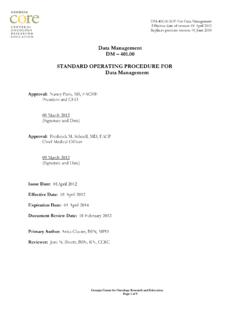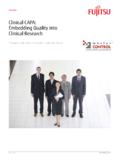Transcription of Study Guide - Royal Society of Biology
1 Qualified Persons involved in the manufacture of pharmaceuticals Study Guide The knowledge and practical experience required by Qualified Persons involved in the manufacture of pharmaceuticals in the UK February 2017 QP Study Guide 2017 Page 2 of 15 Contents Preface The Qualified Person involved in the manufacture of pharmaceuticals: background The three foundation knowledge elements a. Pharmaceutical law and administration b. The role and professional duties of the Qualified Person c. Pharmaceutical Quality Systems Additional knowledge requirements d. Mathematics and statistics e. Medicinal chemistry and therapeutics f. Pharmaceutical formulation and processing g. Pharmaceutical microbiology h. Analysis and testing i. Pharmaceutical packaging j. Active pharmaceutical ingredients k. Investigational medicinal products Practical experience requirements Illustration of requirements Role of the Qualified Person Directives 2001/83/EC and 2001/82/EC Directive 2001/20/EC Other European member states Summary Reason for issue: Issue date: Minor updates to reflect the latest terminology February 2017 QP Study Guide 2017 Page 3 of 15 Preface The three UK professional bodies, also known as the Joint Professional Bodies, administering the Qualified Persons scheme, the Royal Pharmaceutical Society , the Royal Society of Biology and the Royal Society of Chemistry, first introduced a Study Guide for Qualified Persons in 1978 based on Article 23 of 75/319/EEC.
2 Further revisions were completed in 2000, 2004, 2006, 2008 and 2013. This revision was made effective from 20 February 2017. The three professional bodies require an applicant for certification as a Qualified Person to demonstrate a thorough understanding of the foundation knowledge elements and to be able to apply his or her knowledge of Pharmaceutical Quality System (PQS) principles, and to demonstrate understanding of the additional knowledge requirements. The applicant will be required to demonstrate this by reference to the products and processes for which he or she is claiming his or her qualifying experience, which will apply wholly or in part to the Manufacturer s Authorisation(s) (may be known as a Licence herein) detailed on the application. The three professional bodies have determined that the foundation knowledge elements are: pharmaceutical law and administration; the role and professional duties of the Qualified Person; and Pharmaceutical Quality Systems ( the basic philosophy and principles of Quality Assurance), which applies to all sections of this Guide .
3 Certification of eligibility for nomination as a Qualified Person on a Manufacturer s Authorisation is dependent upon the demonstration of both an appropriate knowledge of those activities and disciplines relevant to pharmaceutical manufacturing and Quality Assurance (QA), and appropriate practical experience. The Qualified Person involved in the manufacture of pharmaceuticals: background The Medicines and Healthcare products Regulatory Agency (MHRA) of the UK Department of Health, and the Veterinary Medicines Directorate (VMD), have interpreted the requirements of the Pharmaceutical Directives 2001/83/EC, 2001/20/EC and the Veterinary Directive 2001/82/EC, and applicable implementing UK legislation, through a Study Guide , drawn up by a panel of experts, and have given authority to three professional bodies, (the Royal Pharmaceutical Society , the Royal Society of Biology and the Royal Society of Chemistry), to operate an assessment procedure for their members. The assessments seek to determine an applicant's suitability for being named on a company Manufacturer s Authorisation.
4 The role of the professional bodies is to certify the eligibility of the applicant for nomination as a Qualified Person on a Manufacturer s Authorisation. The applicant must be able to demonstrate that he or she can satisfy the knowledge and experience requirements of Articles 49 and 50 of the "Pharmaceutical Directive" 2001/83/EC (amended by Directive 2004/27/EC), Articles 53 and 54 of the QP Study Guide 2017 Page 4 of 15 "Veterinary Directive" 2001/82/EC (amended by 2004/28/EC), or Article 13 of the clinical Trials Directive 2001/20/EC. Acceptance of a person, certified as eligible for nomination, on a Manufacturer s Authorisation is a matter for the Licensing Authority. The certification process includes submission of a completed application form, the sponsorship of an applicant by a Qualified Person who is also a member of one of the professional bodies (the Royal Pharmaceutical Society , the Royal Society of Biology or the Royal Society of Chemistry), the payment of an application fee, and for applications under the permanent provisions, an oral assessment of the applicant's knowledge and experience.
5 Applications under the transitional provisions of Article 50 of 2001/83/EC do not normally involve an oral assessment. Since the change in veterinary legislation in 2005, applications can no longer be made under the transitional provisions of 2001/82/EC. The VMD has the capacity to appoint QPs independently of the professional bodies. Since 1992 the oral assessments have been conducted by a panel of assessors drawn from all three professional bodies, who are themselves well acquainted with the role of the Qualified Person. The professional bodies have agreed with the MHRA and VMD that, in principle, an individual who has been certified as eligible for nomination as a Qualified Person is also potentially eligible for transfer from one Manufacturer s Authorisation to another, although the final decision for accepting a person as a Qualified Person on a Manufacturer s Authorisation rests with the Licensing Authority in the UK. In consequence the assessors must be satisfied that an applicant, after a suitable induction period, will be able to function as a Qualified Person in any licensed undertaking.
6 Appeals can be made by applicants to their professional body as appropriate. A Guide to the body of knowledge required by the Qualified Person is set out in the following pages. This document should be studied in conjunction with the current edition of the Medicines and Healthcare products Regulatory Agency s (MHRA) "Rules and Guidance for Pharmaceutical Manufacturers and Distributors (known as "the Orange Guide ") and EU legislation defined in EudraLex Volume 4, Guidelines for good manufacturing practices for medicinal products for human and veterinary use . The professional bodies no longer issue a Sources of Reference document. Frequent legislation changes result in the document rapidly becoming out-of-date. Applicants are reminded that a thorough knowledge and understanding of current legislation is required to meet the requirements of this Study Guide . The three foundation knowledge elements a. Pharmaceutical law and administration To assure patient safety, the manufacture and distribution of pharmaceutical products is highly regulated within the European Union.
7 The Qualified Person, in particular, must ensure that all legislative obligations are fully satisfied before any product is released for sale or supply. A Qualified Person must have a comprehensive knowledge of all European and National legislation relating to the manufacture, storage and supply of licensed medicinal products and the interpretation of the law as exemplified in the current edition of the MHRA's "Rules and Guidance for Pharmaceutical Manufacturers and Distributors ", ("the Orange Guide "). Applicants will be expected to demonstrate a thorough understanding of the following: European pharmaceutical directives (including but not limited to 2001/83/EC, 2001/82/EC, 2001/20/EC, 2003/94/EC, 2004/24/EC, 2004/27/EC, 2004/28/EC); QP Study Guide 2017 Page 5 of 15 UK Medicines Act (1968) and other UK national medicines legislation eg Statutory Instruments, and the Veterinary Medicines Regulations, including amendments; marketing, Manufacturing and Wholesaler Authorisation structure, content, application and approval procedures, and responsibilities; the role, legal status and structure of both the European and British Pharmacopoeias, including the Certification procedure of the EDQM; the organisation of the UK MHRA, the role of the European Medicines Agency (EMA), and the role of the Veterinary Medicines Directorate (VMD).
8 Procedures for dealing with complaints and product recalls, the role of the MHRA s Defective Medicines Report Centre, the EMA s CHMP/ CVMP guidelines on quality and the VMD s defect reporting process; pharmacovigilance regulations and requirements; how to interpret and apply the various International Conference on Harmonisation (ICH and VICH) guidelines; the application and scope of Mutual Recognition Agreements (MRAs) between the European Union and Third Countries; how to interpret and apply the regulations concerning importation of pharmaceutical medicinal products from outside of the European Union; and Pharmaceutical Inspection Co-operation Scheme (PICS). b. The role and professional duties of a Qualified Person It is incumbent upon all Qualified Persons, whether or not members of one of the three professional bodies, that they discharge their professional duties in accordance with the Code of Practice for Qualified Persons. The Code of Practice was produced by MHRA, VMD and the three professional bodies and defines the standards of conduct and good practice for the Qualified Person.
9 It is the responsibility of the Qualified Person to certify that a product has been manufactured in accordance with its Marketing Authorisation, clinical Trial Authorisation (where appropriate) and with Good Manufacturing Practice (GMP). The Qualified Person might not have direct line responsibility for many of the activities which could affect compliance with GMP or the Marketing Authorisation. However, they must be aware of any information, incidents or deviations which may influence their decision to certify whether a batch is suitable for release for sale. Applicants will be expected to demonstrate a thorough understanding of the following: the routine legal duties of a Qualified Person, the level of oversight required; including detailed knowledge on the principles and application of risk management within the pharmaceutical industry; batch review and decision making on disposition of batches of pharmaceutical products whether to release for sale or, in the case of non-compliant or defective material to decide on its rejection or rework/reprocessing; QP Study Guide 2017 Page 6 of 15 the key factors, information or metrics that confirm that a batch of pharmaceutical product has a suitable pedigree demonstrated throughout the manufacturing supply chain and has been made to GMP.
10 The principles and practice of current GMP and QA as given in European Directives and Guides on Good Manufacturing Practice including relevant Regulations made under the Medicines Act 1968 and the current edition of the MHRA s Rules and Guidance for Pharmaceutical Manufacturers and Distributors, (the Orange Guide "); the conduct and obligations of Marketing Authorisation (MA) and Manufacturer s / Importer s Authorisation (MIA) holders (and the equivalent for Veterinary Medicines); the GMP requirements for Import and Export of medicinal products within the borders of the EU and between the EU and Third Countries ; the conduct and obligation of clinical Trial Sponsors and IMP providers; the preparation for and management of Regulatory Inspections; the requirements and responsibilities of the QP regarding API certification; the tools and methods used for risk management and their interface with regulatory requirements; and the requirements for QPs when acting as independent contractors or on behalf of third parties.

